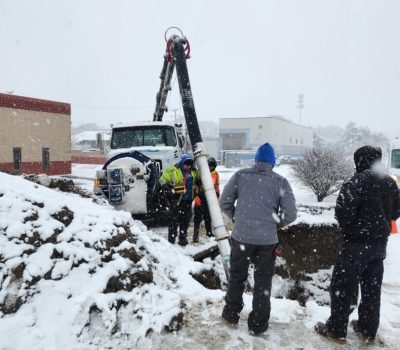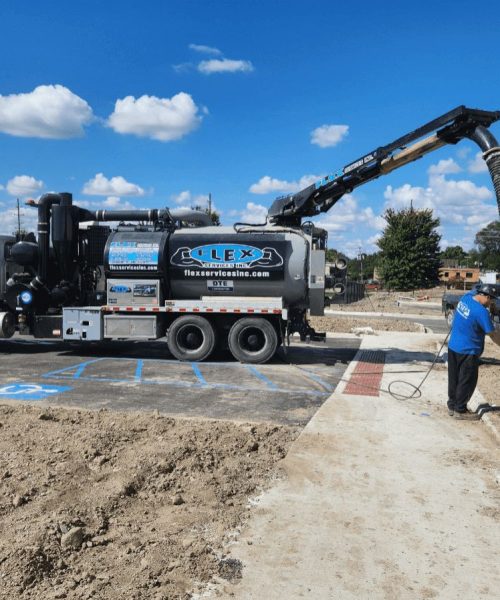Hydro Excavation
Hydro excavation is a cutting-edge, non-destructive digging method that uses pressurized water to break up soil and debris, while a powerful vacuum system simultaneously removes the loosened material. This technique is widely recognized for its precision, safety, and environmental benefits. Unlike traditional mechanical excavation, hydro excavation minimizes the risk of damaging underground utilities and surrounding infrastructure, making it ideal for projects requiring careful excavation in sensitive areas.

Our Approach to Hydro Excavation
At the heart of our hydro excavation services is a commitment to safety, efficiency, and accuracy. Here’s how we carry out this process
Site Analysis and Planning
Before excavation begins, we conduct a detailed analysis of the site to determine the scope of work and locate any underground utilities. This planning stage ensures that our excavation process is both safe and efficient.
We work closely with clients, utility companies, and project managers to develop an excavation plan that minimizes disruptions and complies with all safety regulations.
Water and Vacuum System Setup
Our hydro excavation equipment consists of a high-pressure water system and a powerful vacuum truck. The pressurized water is used to break up soil, clay, and other debris, while the vacuum system immediately removes the material and stores it in a debris tank.
The equipment setup is designed to be flexible, allowing us to work in confined spaces, congested urban areas, or rural environments with ease.
Precise and Controlled Excavation
Hydro excavation allows for precise and controlled digging, making it possible to safely expose underground utilities such as pipes, cables, and electrical lines without causing damage.
The pressurized water is directed in a targeted manner to break up the soil, and the vacuum removes it in real time, preventing over-excavation and minimizing disruption to the surrounding area.
This level of control is especially important in environments with a high density of utilities or where excavation near sensitive structures is required.
Soil Removal and Containment
As the excavation proceeds, the soil and debris are immediately vacuumed up and stored in the debris tank, ensuring a clean and safe worksite. This also prevents contamination of the surrounding area and reduces the need for manual clean-up.
Once the excavation is complete, the debris is transported to an appropriate disposal facility, where it is handled in compliance with environmental regulations.
Post-Excavation Inspection and Reporting
After the excavation is completed, we perform a final inspection to ensure the job has been carried out to the highest standards. If necessary, we can use additional tools like push cameras to inspect the exposed utilities and confirm that no damage has occurred.
We provide detailed reports documenting the excavation process, including the volume of soil removed, the depth of excavation, and the condition of any exposed utilities. These reports are valuable for project planning and future maintenance.
Why Choose Our Hydro Excavation Services?
Hydro excavation allows us to safely dig around underground utilities without risking damage, making it ideal for projects where accuracy is essential.
The combination of high-pressure water and vacuum systems allows for faster and cleaner excavation, reducing downtime and ensuring projects are completed on schedule.
Unlike traditional mechanical digging, hydro excavation is non-destructive, reducing the likelihood of accidents, utility strikes, and costly repairs.
Hydro excavation minimizes soil disturbance and erosion, making it a more environmentally sustainable choice. The process is also cleaner, as the debris is safely contained and disposed of responsibly.

Applications
- Utility Location and Exposure: Hydro excavation is widely used to safely expose underground utilities such as gas lines, water pipes, and electrical cables without causing damage.
- Trenching and Slot Trenching: This method is ideal for creating narrow trenches for utility installation or maintenance, ensuring precision and minimizing disruption to the surrounding area.
- Potholing: Hydro excavation is frequently used for potholing, a process that involves digging small, precise holes to verify the location of underground utilities before larger excavation projects begin.
- Environmental Cleanup: The ability to remove soil and debris with minimal disturbance makes hydro excavation an excellent choice for environmental remediation and cleanup projects.
- Cold Weather Excavation: In cold climates, hydro excavation is preferred because the pressurized water can break up frozen ground more effectively than traditional digging methods.
